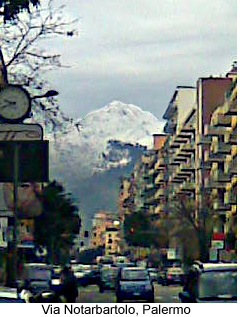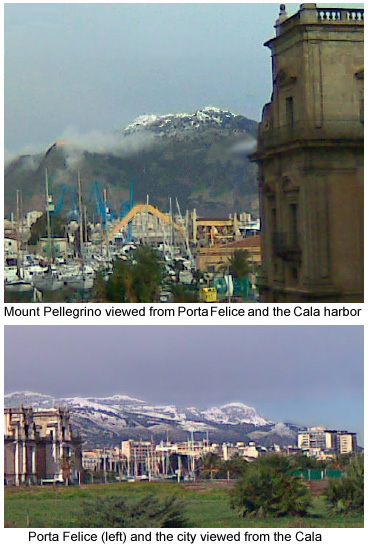...Best of Sicily presents... Best of Sicily Magazine. ... Dedicated to Sicilian art, culture, history, people, places and all things Sicilian. |
by Maria Mazzaro | ||
Magazine Index Best of Sicily Arts & Culture Fashion Food & Wine History & Society About Us Travel Faqs Contact Map of Sicily |
This year was different. The first month of 2009 saw Sicily with more precipitation than in the entire twelve months of the previous year, and January alone nearly broke a record for rain and hail. It's been a decade since any snow actually fell in the city of Palermo. Hilltop Monreale and Altofonte, and the mountains immediately beyond these two towns, are the closest the white stuff usually gets to the capital. (The mountain in photo shown at left is near Monreale.) This is good news, apart from the picturesque, slightly contradictory, novelty of snow on the palm trees. Like many places, Sicily has suffered the effects of climate change, with some very dry , hot years over the last fifteen. The snow on the mountains is a good indication that normality isn't far away, and it hasn't stopped the early almond blooms of February. Historically, Sicily was cooler and wetter than it is today. During the harsh winter of 1062-1063 Roger Hauteville's invading Normans --including his wife Judith-- had to endure several feet of snow at Troina, in the Nebrodi Mountains of north-eastern Sicily, during what was the earliest Sicilian winter then on record. The snow began to fall in late October. This was especially uncomfortable as they were unprepared for the cold, and forced into an isolated part of the town citadel by angry Byzantines and Arabs. True, the Normans were a hardy lot, recently descended from Vikings, but the attack took them by surprise. They even had to eat some of their horses for food, but they eventually overpowered their adversaries, took the town back, and lived to conquer the rest of Sicily. (First, they hung the ringleaders of the Troinans who had iniziated the inconvenient siege, but that's another strory.)
All this probably sounds a bit banal to those who live in colder climes. Here in Sicily the effects of the unseasonably cool weather are heightened by the lack, in most homes, of central heating. In the past, Sicilian snow could be useful and was eagerly anticipated. It is believed that ice cream and sorbet were invented in Sicily, possibly as early as the Roman period but perhaps by the medieval Arabs. The theory, based on what scant descriptions exist, is that a relay of foot-runners brought snow down from the mountains to Catania (from Etna) and Palermo. This was flavored with honey (the Roman theory) or cane sugar (the Arab version) and fruits. Let it snow! About the Author: Maria Mazzaro writes about nature and environmental topics. | |
Top of Page |
 Snow is not as unusual in Sicily as
you may think.
Snow is not as unusual in Sicily as
you may think.  With 199 millimeters
of precipitation in January 2009, there had been more rain and snow in Palermo
province since 1985. The 1973 all-time high for Sicily was 303 millimeters.
It should be mentioned, however, that the areas around Etna, the Peloritans
and Nebrodis get much more precipitation than north-western Sicily.
With 199 millimeters
of precipitation in January 2009, there had been more rain and snow in Palermo
province since 1985. The 1973 all-time high for Sicily was 303 millimeters.
It should be mentioned, however, that the areas around Etna, the Peloritans
and Nebrodis get much more precipitation than north-western Sicily.